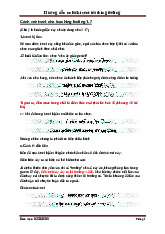


Preview text:
lOMoARcPSD|36041561 1.Introduce Uncle Ho
Ho Chi Minh, born as Nguyen That Thanh in 1890, was a signi昀椀cant
Vietnamese revolutionary 昀椀gure who played a crucial role in his country's
struggle for independence from Imperialismn rule. He assumed the name
Ho Chi Minh, which translates to "Enlightened Teacher of the People," and
emerged as a prominent 昀椀gure in the Vietnamese nationalist movement.
After achieving independence in 1954, Ho served as the 昀椀rst president of
North Vietnam's Democratic Republic of Vietnam until his demise in 1969.
Ho Chi Minh's legacy as a symbol of Vietnamese nationalism and anti-
colonialism continues to be celebrated in Vietnam today. 2.Tale of Resilience
Learn about Ho Chi Minh's perseverance and determination in leading the
resistance against foreign occupiers.
-The Declaration of Independence
Explore the historic signi昀椀cance of the document that declared Vietnam's
independence and shaped the nation's destiny -Unity in Diversity
Discover how Ho Chi Minh fostered unity among diverse ethnic groups,
laying the foundation for a united Vietnam.
>> Uncle Ho's Monument holds great signi昀椀cance for the Vietnamese
people and serves as a symbol of national pride. In this presentation, we
will explore the importance of this memorial site and the purpose of
sharing its story with the world 3.Timeline
The construction process began on September 2, 1973, and concluded on August 29, 1975.
-In March 1970, Vietnam sent architects to Moscow to participate in the design.
-On February 9, 1971, the Agreement between the two Governments on
the Soviet Union helping Vietnam design and build President Ho Chi Minh's
Mausoleum was o昀케cially signed and construction began.
Downloaded by Nga T??ng (ngahuong55@gmail.com) lOMoARcPSD|36041561
-But in April 1972, the US imperialists bombed the North again, so the
Government postponed the construction of the Mausoleum.
-In early 1973, the Paris Agreement was signed and peace was restored.
We try to have the Mausoleum project completed on the occasion of the
30th anniversary of the founding of the Democratic Republic of Vietnam (1945-1975). 4. Architectural
Explore the remarkable life and achievements of Ho Chi Minh, the
renowned leader of Vietnam. Learn about his crucial role in shaping the
nation's history and how his ideals continue to inspire generations today.
-Architecture and Design Majestic Exterior
Marvel at the grand architecture blending French colonial in昀氀uences with
traditional Vietnamese elements. Elegant Interior
Step inside to witness the serene and digni昀椀ed atmosphere of the
mausoleum dedicated to Ho Chi Minh.
-The mausoleum consisting of 3 layers with a height of 21.6 meters, a
width of 41.2 meters, the lower layer creates the shape of three steps, the
middle layer is the central structure of the mausoleum including the exam
room. Comedies and corridors and stairs.
The outside of the mausoleum is covered with gray granite, the inside is
made of polished gray and red stone. Around the four sides are rows of
square marble columns, the top layer is a three-step mausoleum roof.
On the main side is the inscription: "PRESIDENT HO CHI MINH" in plum-
colored pink stone. Surrounding the mausoleum are gardens where more
than 250 species of plants are grown from all over Vietnam.
5. Cultural signi昀椀cant
Uncle Ho's Mausoleum in Vietnam is a revered site symbolizing the
cultural and national signi昀椀cance of Ho Chi Minh, the father of modern Vietnam.
This monumental structure stands as a testament to Vietnamese identity,
unity, and patriotism. It embodies deep cultural reverence, serving as a
place of respect and inspiration.
Downloaded by Nga T??ng (ngahuong55@gmail.com) lOMoARcPSD|36041561
Preserving Ho Chi Minh's legacy, the mausoleum educates visitors about
his ideals and contributions while uniting diverse individuals under a shared national identity. 6.Conclusion
Overall, Uncle Ho's Mausoleum is not just a physical structure; it embodies
the values, history, and aspirations of the Vietnamese people, making it
an enduring symbol of national pride and cultural heritage.
Downloaded by Nga T??ng (ngahuong55@gmail.com)




